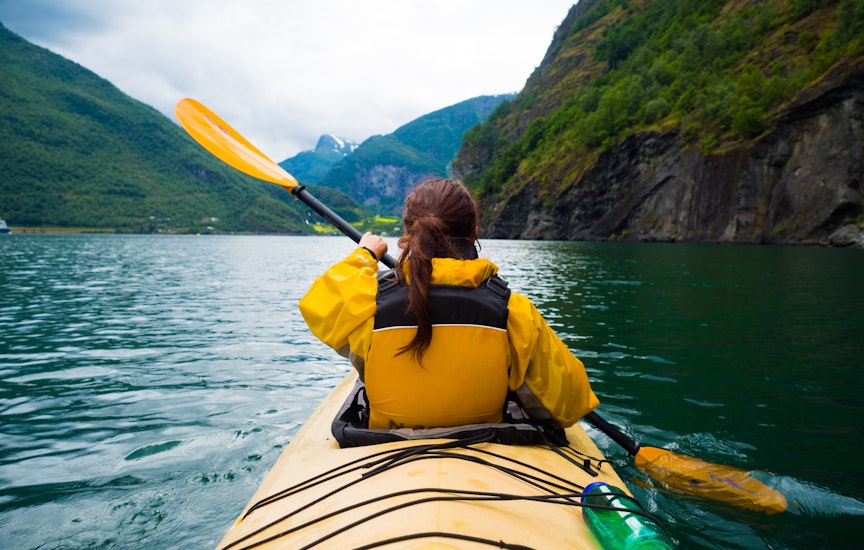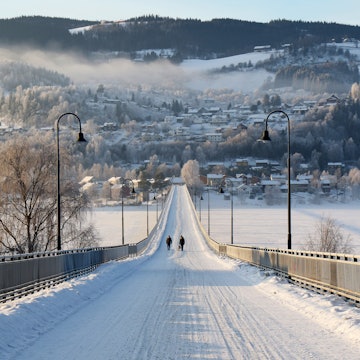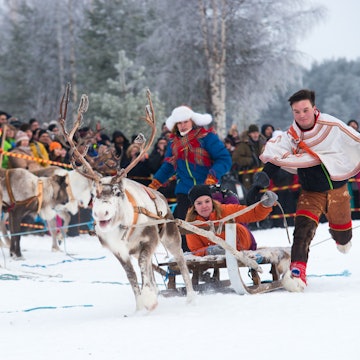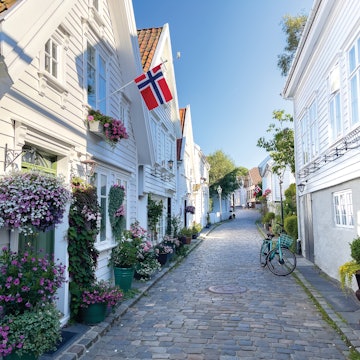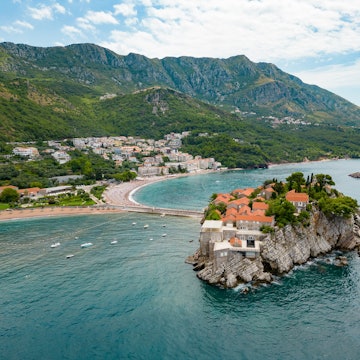

A boat tour in the frigid waters off Svalbard, Norway. Ondrej Prosicky/Shutterstock
Closer to the North Pole than to Oslo, Svalbard’s raw, bleak beauty entices travelers seeking a taste of polar adventure. Anyone who makes it this far north is, in a sense, setting out where pioneering explorers, resilient miners and polar bears have laid footprints before them.
The Norwegian islands’ biggest settlement is Longyearbyen, overlooking Isfjorden and resting haphazardly near the glacial tongues of Longyearbreen and Larsbreen. Truly isolated yet with surprisingly easy reach, the small town’s international population lends it the feel of a European ski resort. Yet it’s the frozen fjords, mountains and ice floes lying beyond that truly beckon.
While cruise ships and budget air links have made Svalbard more accessible than ever, it remains a majestically desolate place that calls the intrepid to venture further than they’ve been before. These are the best things to do in Svalbard.

1. Get an in-depth intro to the Svalbard archipelago at Longyearbyen’s museums
While we wouldn’t call Longyearbyen’s industrial waterfront and Arctic-hardy architecture picturesque, a decent selection of restaurants and bars and a few diverting museums make it an excellent base for the array of activities in the surrounding mountains and valleys. You can count on a terrific primer on the history and nature of human habitation and industry here before you head out to experience the wilderness for yourself.
Start at the Svalbard Museum for an introduction to the archipelago from every angle. In low-tech but detail-packed displays, expect to learn about the people and animals who reside here; the history of hunting, trapping, whaling and mining in the islands; the regional geology; and the impact of climate change. Closer to the waterfront, the independent North Pole Expedition Museum takes you on a deep dive through the history of polar exploration via original footage, newspapers and historical artifacts.
Planning tip: Reserve ahead for meals at a pair of fabulous Longyearbyen restaurants. In the festive, plant-festooned greenhouse of Vinterhagen at Mary-Ann’s Polarrigg, you can tuck into local specialities like reindeer and seal steak. And occupying a stunningly converted wooden mining warehouse, Gruvelageret serves an exceptional New Nordic set menu.

2. Set out on an Arctic adventure – think hikes, huskies and snowmobiles
At its core, Svalbard is a destination for the adventurer. Accordingly, activity providers (almost all based in Longyearbyen) work together to offer experiences both close to town and deep into the archipelago’s frozen reaches. The tourist office is a great first port of call to arrange excursions in both summer and winter.
On a guided hike, you can explore the valleys and peaks near Longyearbyen for just a few hours, taking in former mines, strewn with long-abandoned industrial artifacts, that now constitute protected monuments. One popular route leads you to the 424m-high (1391ft-high) summit of Platåfjellet, a peak overlooking the town with views from the top across Adventfjorden. Another will take you past mining relics as you ascend Blomsterdalshøgda, 320m (1050ft) above sea level; on the descent, you’ll walk past the striking entrance to the Global Seed Vault, a library of seeds serving as an insurance policy against agricultural Armageddon (visitors aren’t allowed inside). If you want to go even further back into the mists of mining times, you can trek to the abandoned mining settlement at Hiorthamn, over the other side of the fjord from Longyearbyen.
While dogsledding trips (!!) can be surprisingly physical, the chance to harness your own team of huskies at one of the dog yards is a hilariously joyful experience. And multiday expeditions on foot or by ski, snowmobile, dogsled or kayak reach deeper into Svalbard’s silent heart and scratch a stronger itch for adventure.
Planning tip: Many travelers who prefer to get around independently might find the idea of joining an organized tour unappealing. However, there are unique risks on Svalbard. Anyone traveling outside Longyearbyen’s town boundary requires polar-bear protection – namely, a firearm, and the process to acquire the necessary permit is strict and lengthy. What’s more, travel on the archipelago is restricted, and “public transport” as most understand it doesn’t exist. This means that for the overwhelming majority of short-stay visitors, guided tours with established operators will provide the most straightforward, enjoyable and safe experiences.

3. Go walrus spotting
After being hunted extensively from the 17th to 19th centuries, walrus colonies on Svalbard were once on the verge of collapse – yet these massive mammals have made a comeback since they became a protected species in 1952. Though estimates vary, the Norwegian Polar Institute reckons around 2000 of the blubbery beasts now reside on Svalbard. This means you’ll have a good chance of seeing a few in their natural habitat.
Summer walrus safaris commonly focus on Borebukta, on the northwestern side of Isfjorden. The journey to get there takes around an hour, taking you past mesmerizing snowy peaks before reaching the walruses’ favored spot. You’ll have plenty of time to see them lolling sociably on the beach or ice, as they look for mollusks in the shallows or haul themselves up from the water. As enormous as they are, they’re surprisingly graceful in their barren native habitat.
Planning tip: You can expect nice and cozy conditions in the cabin of your boat – but the Arctic wind will bite once you’re out walrus-watching out on deck; dress accordingly. You can book all tours through the tourist office.

4. Get a taste of the Soviet era at the Barentsburg and Pyramiden mining settlements
Though Svalbard is officially a Norwegian territory, a quirk of the 1920 Spitsbergen Treaty means that all signatories have a right to enjoy Svalbard’s natural resources. As a result, Russian mining settlements sprang up – and visiting them is a Svalbard highlight.
You’ll feel you’ve stumbled upon a forgotten outpost of the Soviet Union at the ends of the earth at Barentsburg (60km/37 miles southwest of Longyearbyen), which still supports an active coal mine (though its seams are dwindling). Cyrillic signage, murals of workers in heroic poses and the wonderfully retro (if hardly posh) Hotel Barentsburg make for a mind-bending time warp.
Named for the pyramid-shaped mountain nearby, the mine at Pyramiden was closed in 1998 when it ceased turning a profit. Save for a few hardy souls maintaining amenities for tourists, it’s now effectively a ghost town. Yet few visitors will forget the sight of abandoned Soviet-era buildings and a monument to Lenin amid the barren Arctic terrain – a juxtaposition of the pristine and the post-apocalyptic.
Planning tip: Currently, no operators are offering tours to these settlements, and excursions run by Russian-owned tour companies are not being promoted by Visit Svalbard due to the ongoing war in Ukraine. Contact the tourist office before you travel if you have your heart set on visiting these weird places.

5. Explore Svalbard’s extreme north in Ny-Ålesund
On the southern edge of Kongsfjorden, isolated Ny-Ålesund claims the title of the world’s northernmost permanently inhabited town. With only 40 year-round residents (more in summer, when the population of researchers increases), Ny-Ålesund is a still place, with just a few streets and a handful of sights. But precisely because it’s so small, its adventurous past is so captivating. It’s best known as the starting point for a number of expeditions to the North Pole, notably those by Roald Amundsen on the airship Norge and Umberto Nobile on the doomed Italia.
In summer, day-long boat trips travel here and back from Longyearbyen’s boat-departure point a couple of times a week. Plan for about 20 to 30 minutes in the town’s small museum, where exhibits cover the settlement’s past and its present, from the realities of mining at N 79° (it’s, um, really cold up here) to scientific research projects that are in progress to the personal stories of some of the town’s permanent residents. Across the road is Kongsfjordbutikk, a souvenir emporium with Ny-Ålesund merch aplenty, including plushies, blankets, tote bags and clothes.
Planning tip: Due to the finely tuned scientific and security equipment all over Ny-Ålesund, Bluetooth, wi-fi and any other wireless kit is strictly prohibited within a 20km (12.4-mile) radius of the outpost. This only makes a fascinatingly isolated place even more so.

6. Hope to spot a polar bear (but don’t count on it)
From warning signs with the silhouette of the predator and reading “Gjelder hele Svalbard” (“Applies to all of Svalbard”) to postcards on souvenir stands, the polar bear is never far from people’s minds on these islands. For good reason: more than 2000 of the powerful creatures live or pass through the archipelago, preying on seals from the sea ice. But as most know, these magnificent animals are highly vulnerable to a changing climate, for as the ice sheet shrinks so too does their territory, and opportunity to hunt successfully. It’s illegal to hunt, chase or disturb polar bears anywhere in Svalbard or Norway.
While your chances of encountering a live bear are slim, the historically stuffed ones in hotels around Longyearbyen are always visible. Such taxidermy serves as a reminder of how much attitudes have changed towards protecting this elusive marine mammal.
Planning tip: Whether you’re one of the lucky few who sees a polar or not, a t-shirt or mug depicting the iconic “Gjelder hele Svalbard” sign will be a worthy souvenir of any visit here. In Longyearbyen, check out the shops at Lompen Senteret, or the gift shop at the Svalbard Museum.
This article was adapted from Lonely Planet’s Scandinavia guidebook, published in July 2025.




